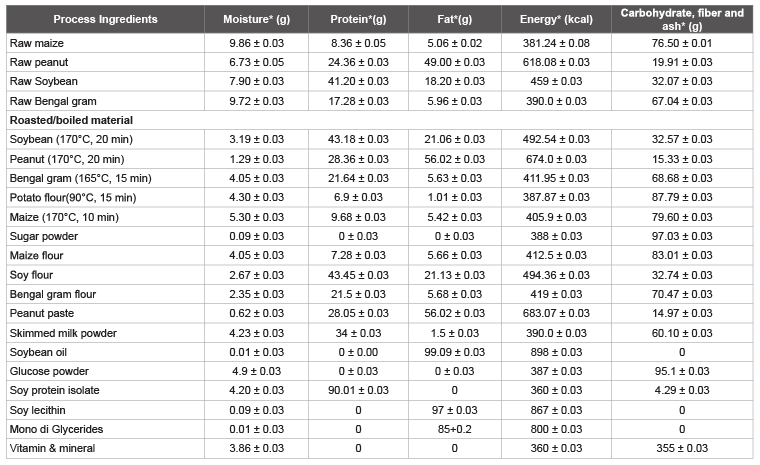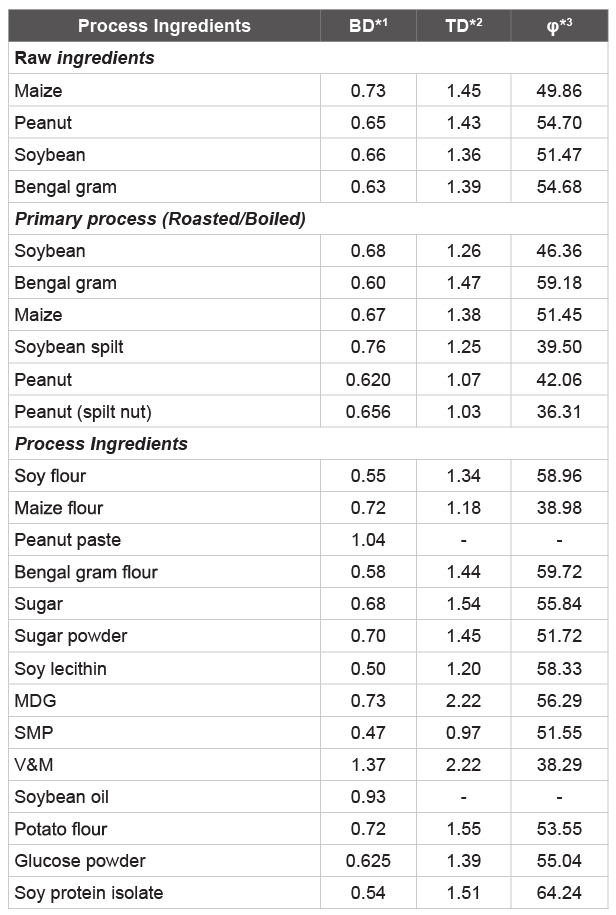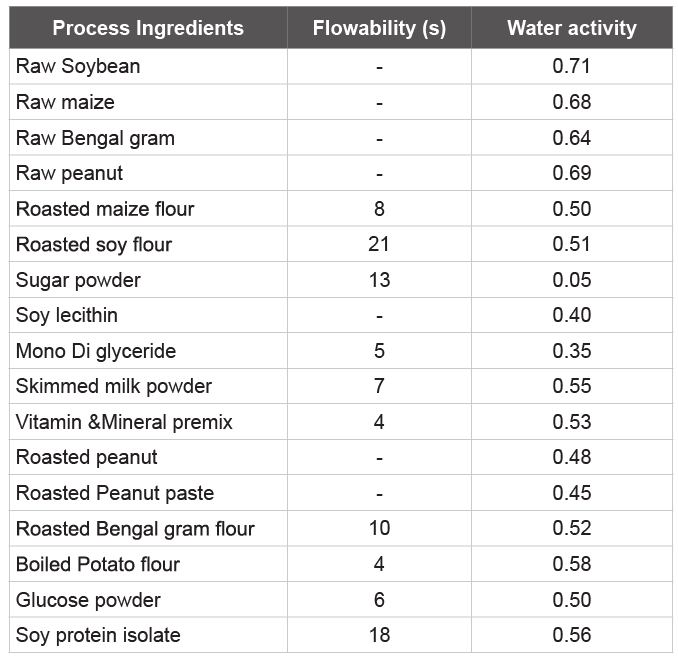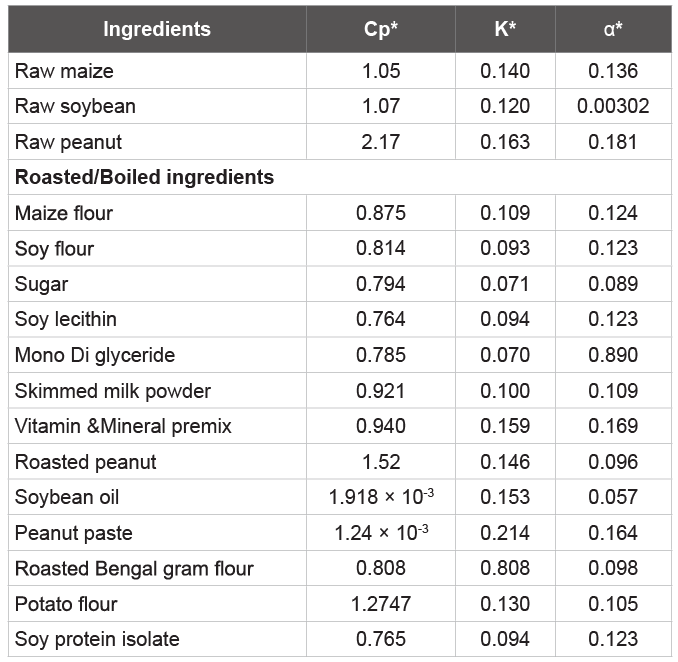
Table 1: The proximate composition of raw and processed ingredients used in the preparation of TF-RTE foods. *Data are average of the values of selected ingredients i.e. Mean ± SD, SD=standard deviation


Raigar RK* Mishra HN
Agricultural and Food Engineering Department, Indian Institute of Technology Kharagpur, West Bengal, India*Corresponding author: Raigar RK, Food Chemistry and Technology Lab, Agricultural & Food Engineering Department, Indian Institute of Technology Kharagpur, Kharagpur, West Bengal-721302, India, Tel: +91- 3222- 283130; Fax: +91 3222 283130/282244/255303; E-mail: rakesh@agfe.iitkgp.ernet.in; rakeshiitkgp07@gmail.com
This article deals with physicochemical, thermal and functional properties of cereals (maize), pulses (Bengal gram) vegetables (potato flour), oil seed (peanut, soybean), sweetener (sugar and glucose powder), milk powder, soybean oil, emulsifier (lecithin and Mono Di glyceride) and vitamin & mineral premix used for the preparation of ready to eat therapeutic health food for malnourished children. The physical (bulk and true density, porosity and flowability), chemical (moisture, fat, protein and total energy), thermal properties (thermal conductivity, thermal diffusivity and volumetric specific heat) and functional properties (protein digestibility) were determined using standard protocols. The bulk density, particle and porosity of raw and processed ingredients were varied from 0.54 to 1.37 g/cc, 1.03 to 2.37 g/cc and 0.40 to 0.60 % respectively. The water activity (aw), flowability, thermal conductivity, thermal diffusivity and specific heat were 0.02 to 0.76, 4 to 18 S, 0.071 to 0.214 W/mk, 0.0032 to 0.890 mm2 /s and 1.24 x 10-3 to 0.52 MJ/m3 k, respectively. The roasted soybean flour has maximum (82%) protein digestibility; the respective data for the roasted peanut paste was (79%) and roasted Bengal gram flour (79%).
Porosity; Thermal properties; Protein digestibility and flowability
Malnutrition is an important public health problem and it is a primary contributor to the total global disease burden. It is the principal cause of half deaths of children in India. Most deaths could be prevented if this one issue is tackled [1]. Severe acute malnutrition (SAM) among children under 5 years of age remains a major embarrassment and an impediment to optimal human capital development in India. Treating SAM children in hospitals is not always desirable or practical in rural settings home treatment may be better [2]. The energy rich ready-to-eat (RTE) health foods provided to malnourished children may be a paradigm shift in managing SAM. The evidence is mostly restricted to severe malnutrition, where home-based and community-based therapy with nutrient rich foods has been found to be more cost-effective than in-patient care of SAM [3]. Care taker can treat SAM patients by preparing homemade food such as flour porridge or TF-RTE heath food.
TF-RTE health food is made according to a standard, energy-rich composition defined by the World Health Organization (WHO). The TFRTE can be made using cereals flours, oilseed flours, sugars, vegetable oils, micronutrients and powdered milk ingredients embedded in a lipidrich paste, resulting in an energy rich food paste that resists microbial contamination. The advantage of TF-RTE food compared with most other commercial complementary foods is low moisture content which normally does not spoil due to bacterial contamination and it has a long shelf life. It does not require refrigeration for storage. It does not requires any preparation before consumption. The ingredient composition, physical, chemical, functional and thermal properties are highly sensitive to the production of TF-RTE foods.
A rational approach to the design of process machinery, equipment and facilities will involve a theoretical basis, laying down the mathematical and mechanical foundations for the production of peanut based and nonpeanut based TF-RTE food products. The physical properties do not only constitute the basic engineering data required for machine and equipment design, but they also aid the selection of suitable methods for obtaining those data. The value of this basic information is not only important to engineers but also to the food scientist, processors and other scientists who may want to exploit these properties and find new uses [4].
The bulk density is an important physical property of raw and processed cereals, oilseeds flours and powdery materials. They play an important role in storage, transportation and marketing [5]. The flowability is influenced by powder related factors, such as morphology, size distribution, true density, surface area and its chemical compositions. Jaya and Das [6] explained that flowability is the ability of a powder to flow in the surface of the machine, and it is essential for the design of conveying equipment. Jhosi et al. [7] also reported that the physicochemical characteristic of lentil starch is the in providing a sound scientific basis for new product development. The product characteristics were significantly influenced due to change in physical and chemical property of protein and carbohydrates [8].
The functional properties are significantly influenced by the processing of peanut soybean flour, cereal flour, pulses flour, and milk powder. Currently, these flours have been used as a food ingredient in the development of health food for malnutrition, due to its functional properties for its high protein content [9,10]. Du et al. [9] suggested that the functionality of proteins is closely related to their physical and chemical properties, such as molecular weight, amino acid composition, processing temperature and ionic strength of the food system. The functional properties such as water absorption, oil absorption and protein solubility affect the processing, texture, and appearance of the product. These are critical to the production of associated foods.
Oladunmoy et al. [11] reported that thermal conductivity, specific heat and diffusivity of TF- RTE paste would serve useful in predicting of quantity of heat to be transferred into known mass of mixed ingredients paste. The knowledge of physico-thermo and functional properties of different raw and processed material of TF-RTE is essential in its formulation and equipment design for processing of TF- RTE health food.
These properties are affected by processing stages during the production chain from raw material to finished products. Therefore, it is necessary to know about these properties performance for the protection of the quality of the technological process of TF-RTE food paste. The density, porosity, flowability, thermal and functional properties were considered for this study of the selected material.
The mature and cleaned samples of peanut, maize, soybean, Bengal gram, potato flour, glucose powder, sugar, skimmed milk powder and soybean oil were procured from the local market in Kharagpur, West Bengal, India. The vitamin and mineral premix was purchased from M/s Hexagon Nutrition Pvt. Ltd. Mumbai and Mono Di-Glycerides from M/s Fine Organic Pvt. Ltd. Mumbai. The samples were stored in clean steel containers at cool and dry places for further testing. The peanut, maize, soybean, Bengal gram, potato flour were roasted and boiled by using standard methods. The glucose powder, sugar, skimmed milk powder, soybean oil, vitamin, mineral premix and Mono Di-Glycerides were considered as process ingredients.
The moisture content of the raw roasted and process ingredients were determined by using the standard method which was described by Joshi et al. [12]. The fat content was estimated by a known amount of the sample (5g). It was defatted in an automated Soxhlet extraction equipment (Soxtherm 416, Gerhardt GmbH & Co. KG, Germany) using hexane (boiling point range 68–70°C) as the solvent (flour-to-solvent ratio of 1:10 w/v) for 4 h. Defatted samples and extracted oil were dried overnight (∼10–12 h) in a hot air oven to remove residual traces of hexane. The samples were weighed to calculate fat content [13].
The total protein content was measured using the Kjeldahl Method [14] with an automatic Kjeldahl apparatus (UDK 159; VELP Scientific, Inc., Italy) using 0.1 g of raw, roasted, process and boiled sample. The factor N × 6.25 was used to convert the total nitrogen to protein content. The ash and crude fiber content were determined using standard laboratory protocols. The amount of available carbohydrates was determined by distinction from the protein, fat, moisture, ash and crude fibre contents. Energy values were calculated using the Atwater general factor system: carbohydrate (4 Kcal g−1), fat (9 Kcal g−1) and protein (4 Kcal g−1) [15]. All experiments were performed on three replicates.
Density: The 100 g of raw, roasted/boiled and process samples were gently filled in 200 mL measuring cylinder. The bottom of the cylinder was slowly tapped on a laboratory table several times until there was no further change in filled volume after filling to the 200 mL mark. The volume occupied by the flour was recorded as bulk volume. The bulk density was calculated as the ratio of mass per unit of volume (g/cc) [16]. Measurements were made in triplicate.
Particle density: Chang [17] reported that particle density is the ratio of the mass to the actual volume of the flour particles. The particle density was determined by using helium gas pycnometer method [18]. Automatic gas pycnometer (Model No.Ultrapyc1200e Quantachrome, Boynton Beach, FL) was used to measure the particle density of flour samples.
Porosity: The porosity (εa ) indicates the total volume fraction of void space or air relative to the total sample volume. The porosity was calculated using an Eqn. (1)
$${\varepsilon _a} = 1 - {{{\rho _b}} \over {{\rho _p}}}..................1$$
where, ρb is bulk density (it includes all pores in the material), and ρp is the particle density.
Flowability: Flowability is the ability of flour to flow and was measured in per unit time (second). The total time was noted during the discharge of flour in the prescribed opening of rectangular slit size (7 mm × 4 mm) on the surface of rotary drum. The speed of the rotary drum was kept constant at 30 rpm by using the gear assembly and motor. The weight of the sample in the rotating drum was taken 25 times of its bulk density (g/cc) [18].
Water activity: A Fast-lab water activity meter (Gbx, Romans surIsere Cedex, France) was used to measure the water activity of the raw and roasted/boiled samples, oilseed flour and other ingredients [19]. The instrument was calibrated with sodium chloride and potassium sulfate before starting the experiment. The sample was poured in a round and flat bottom dish. The sample dish was placed inside the sealed chamber. The vertical load of water activity meter pushed on the dish and pressed the analyze button. After loading, the chamber was pressed inside and loaded to an airtight condition by vertical load position. The water activity of entire sample was recorded from the digital display of instrument with respect to atmospheric temperature.
The thermal properties of the samples were measured by thermal property analyzer (Model KD2, Decagon Devices Inc., WA). It consists of 1.3 mm diameter, 30 mm length of two stainless steel needles, with 6 mm spacing. The instruments having a heat source element and temperature sensor for measurements. Regulating power of the heating element was controlled by in built microcontroller and measured the probe temperature. On the basis of the theory described above thermal conductivity, diffusivity and specific heat were evaluated from its own inherent software [20]. The probe was inserted in the sample tube and pressed the analyze button of the instrument. After 30 seconds the reading was noted from the digital display window of instrument. The triplicate measurement was conducted, and average values were taken from each sample [18,21].
The protein digestibility of the samples was assessed by the multienzyme in-vitro protein digestibility method as suggested by Srivastav et al. [22] and Hsu et al. [23]. It consists of trypsin, chymotrypsin, and peptidase multi enzymes. Prior to digestibility enzymes activity was determined using freshly made sodium casemate during experiments.
Proximate composition: The proximate composition of all selected ingredients studied and reported in Table 1. Proximate analysis showed significant variation in moisture, fat, protein, carbohydrate and energy contents of the sample. Due to change in moisture content, the microbiology and nutritional qualities of TF-RTE health food were also influenced. The low moisture food such as porridge, biscuits, and weaning foods are important diet for young children [24]. Dietary proteins play an important role in the treatment of malnutrition children. Golden et al. [25] reported that the optimal protein content and quality of the protein is important diet and suggested 24 g protein per 1000 kcal food for moderately malnourished children. The soya protein isolate, animal protein, and peanut are considered major source of protein both in terms of quality for TF-RTE health food. The fat content is the major source of energy in the TF- RTE health food. Food used for malnutrition and emergency, a fat content of 30-40% has been recommended (WHO). The suitable source of fat content includes vegetable oil and peanut butter (Table 1). For low water content food, lower fiber content is recommended. The energy density was examined in 6-18 months of children by Brown et al. [26]. The energy content of health food is more important, compared to other normal food. The processing operation may have influenced the chemical composition, weight distribution of raw materials, losses of the endosperm and hull of the kernels.

Table 1: The proximate composition of raw and processed ingredients used in the preparation of TF-RTE foods. *Data are average of the values of selected ingredients i.e. Mean ± SD, SD=standard deviation
Density and porosity: The bulk and particle density, and porosity values of different raw, roasted/boiled and processed ingredients are reported in Table 2. The bulk and true density of ingredients are important properties, which are useful in designing and deciding the storage volume, capacity of tanks and suggesting storage period. The flowability of the ingredients is influenced by the particle density. This particle density would help in flowability of ingredients during the conveying and gravity flow of material in the production of TF-RTE health food. The higher values for bulk and particle density were noticed in vitamin and mineral premix and grounded sugar particles (Table 2). This might be due to the high mass of individual particle of mineral content and sugar particles.
Flowability: The flowability was determined for different ingredients used in the preparation of RTE-TF food and reported (Table 3). The flowability data would help in designing, material handling equipment and its flow characteristics in the storage tanks during filling and emptying. The additional time taken in flowability indicates the cohesive nature of flour. The higher flowability value was observed in soy flour, soy protein isolate and skimmed milk powders. These flours were too cohesive and sticky. A hammer was fitted outside in the storage tanks for easy flowing for cohesive and sticky flours. The vitamin and mineral premix and mono di-glycerides flour are free flowing powder. These powders took the lowest flowability time for discharge from the opening. The other ingredients showed a medium flow in flowability. The rise in flowability time might be due to high particle density, fat content and sticky nature in the material [27].
Water activity: The low water activity of the material provides stability and contributes to the shelf life of product. The water activity value also helps in determining the microbiological growth and spoilage factor. The water activity significantly decreased after roasting and boiling process due to evaporation of water at higher processing temperature. It is also influenced by storage temperature, humidity and time. This might be due to water absorbed from atmosphere by the processed ingredients [28]. The water activity of various raw and processed ingredients used in the preparation of TF-RTE health food was reported in table 4.

Table 2: The bulk density, true density and porosity of raw and processed
ingredients used in the production of TF-RTE foods.
BD*1
=Bulk density (g/cc), TD*2
=true density (g/cc) and φ*3
=porosity (%)
The thermal properties such as thermal conductivity, thermal diffusivity, and specific heat value of ingredients used in preparation of TF-RTE health food were reported (Table 4). The highest thermal conductivity was observed in Bengal gram flour (0.098 W/mk), and lowest in mono di glyceride (0.070 W/mk). These properties would help in designing of mixers, roaster and equipment for conveying for TF-RTE food production. The change in thermal properties occurred due to variation in chemical structure, moisture content and variety of the sample.
The in vitro-protein digestibility of cereals, pulses and oil seeds were studied and shown in table 5. The protein digestibility of maize grain significantly increased after the process of roasting. The protein digestibility of maize gets impaired by the pericarp and germ parts. Perhaps lipid present in the germ forms a coating over protein components within the grain thus restricting the accessibility to proteases. Protein attached to pericarp fragments produced in milling may be less digestible of alphaamylase after cooking in vitro protein because of reduced accessibility to proteases in maize grains [29]. Marsmana et al. [30] reported that the PD value gets influenced with the temperature and moisture content after extrusion cooking of soy meal.

Table 3: Flowability and water activity of raw and process ingredients used in preparation of TF-RTE food.

Table 4:Thermal properties raw and process ingredients used in preparation of TF-RTE food.
Cp*=specific heat (MJ/m3 k), k*=thermal conductivity (W/mk), α*=thermal diffusivity (mm2 /s)

Table 5: The protein digestibility of cereal, pulses and oil seeds for TF-RTE food.
This work was aimed to explore the physical, chemical, functional, nutritional and thermal properties of selected raw materials and processed ingredients used in the preparation of TF-RTE food. The data shows a significant nutritional change in terms of protein, fat and energy values. The maximum bulk density (0.73 g/cc) and true density (1.54 g/cc) were found in sugar and maize among the other materials. The lowest flowability (4s) was noticed in potato flour, vitamins and mineral premix. The evaporation of water after roasting and boiling of raw material resulted in decreased thermal conductivity, thermal diffusivity, and specific heat. The thermal properties of maize, soybean and peanut were strongly affected by a loss of moisture content after roasting. The values of thermal conductivity of roasted maize, soybean and peanut were 0.140 to 0.109 W/mk, 0.120-0.093 W/mk and 0.163-0.146 W/mk, respectively. Amongst all the roasted flour, soy flour had better protein digestibility (82%). These explored data based on pre (raw material) and post operation (roasted/boiled) would be highly beneficial in the process design of health food for optimum utilities.
The financial support provided by Department of Biotechnology, Government of India, New Delhi for the study thankfully acknowledged.
Download Provisional PDF Here
Article Type: Research Article
Citation: Raigar RK, Mishra HN (2015) Physicochemical, Nutritional and Functional Properties of Selected Material Used for the Production of Ready-to-Eat Health Foods for Malnourished children. Nutr Food Technol 1(2): doi http://dx.doi.org/10.16966/2470-6086.109
Copyright:© 2015 Raigar RK, et al. This is an open-access article distributed under the terms of the Creative Commons Attribution License, which permits unrestricted use, distribution, and reproduction in any medium, provided the original author and source are credited.
Publication history:
All Sci Forschen Journals are Open Access